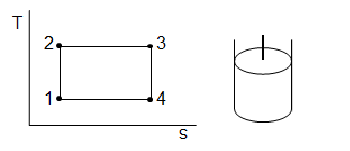
Elements Of Electromagnetics
7th Edition
ISBN: 9780190698614
Author: Sadiku, Matthew N. O.
Publisher: Oxford University Press
expand_more
expand_more
format_list_bulleted
Question
thumb_up100%
Air in a piston-cylinder assembly undergoes a Carnot power cycle. For the process numbers used in this problem refer to Figure 5.13 in the textbook and the figure below for a T-s diagram. The isothermal expansion and compression occur at 840 K and 295 K respectively. The pressures at the beginning and the end of the cycle are p1 = 400 kPa and p4 = 100 kPa, respectively. Assuming the ideal gas model for both constant and variable heat capacity, cp = 1.005 kJ/kg·K and k = 1.40 determine:
a) the pressures p2 and p3.
b) the heat transfer and work for each process.
c) the thermal effici
ency.

Transcribed Image Text:T
2.
1
3
4
S
Đ
Expert Solution
This question has been solved!
Explore an expertly crafted, step-by-step solution for a thorough understanding of key concepts.
This is a popular solution
Trending nowThis is a popular solution!
Step by stepSolved in 4 steps with 9 images

Knowledge Booster
Learn more about
Need a deep-dive on the concept behind this application? Look no further. Learn more about this topic, mechanical-engineering and related others by exploring similar questions and additional content below.Similar questions
- I need help with the diagnrams for this thermo practice problem 2 kg of air in a piston cylinder initially at P1=101 kPa, T1= 300 K undergoes a cycle made up of three processes: 1-2 Isothermal compression until the volume is (1/15) of its original value.2-3 Constant Pressure heating3-1 Isentropic Expansion back to the initial state Assume air is an ideal gas with constant specific heats with the following values: Cpo=1.027kJ/kgK; Cvo= 0.740 kJ/kgK; R=0.287 kJ/kgK; ɣ=1.388 Sketch this cycle on a P-v diagram and on a T-s diagram, clearly indicating all state points and the three processes.arrow_forwardExplain the heat transferred from a furnace (Q) to convert the boiler feed water at 25 ° C into superheated steam at 17 bar and 250 ° C.arrow_forwardIn an air-standard Brayton cycle the air enters the compressor at 0.1 MPa and 15°C. The pressure leaving the compressor is 1.0 MPa, and the maximum temperature in the cycle is 1100°C. Determine the pressure and temperature at each point in the cycle and the compressor work, turbine work, and cycle efficiency. For each of the control volumes analyzed, the model is ideal gas with constant specific heat, at 300 K, and each process is steady state with no kinetic or potential energy changesarrow_forward
- In a steam power plant operating at steady state is supplied to the high pressure turbine at 5 MPa and 450 °C. after expansion to 500 kPa the steam is reheated at constant pressure to the original temperature. The steam expands in in the low pressure turbine to an exhaust pressure of 10 kPa.arrow_forwardAn engine has the Lenoir thermodynamic cycle as shown in the figure. Given: 1 mol of ideal gas CP,m = 3.5 R P1 = 2 atm ; P2 = 5 atm V1 = 3000 cm3 ; V3 = 6000 cm3 Find the following: Temperature at (P1, V1), (P2, V2), and (P2, V1) QH and Qc (Note; QH comes from Process 1->2; Proces 2-3 is considered isentropic efficiency of the enginearrow_forwardPlease explain each steparrow_forward
arrow_back_ios
arrow_forward_ios
Recommended textbooks for you
 Elements Of ElectromagneticsMechanical EngineeringISBN:9780190698614Author:Sadiku, Matthew N. O.Publisher:Oxford University Press
Elements Of ElectromagneticsMechanical EngineeringISBN:9780190698614Author:Sadiku, Matthew N. O.Publisher:Oxford University Press Mechanics of Materials (10th Edition)Mechanical EngineeringISBN:9780134319650Author:Russell C. HibbelerPublisher:PEARSON
Mechanics of Materials (10th Edition)Mechanical EngineeringISBN:9780134319650Author:Russell C. HibbelerPublisher:PEARSON Thermodynamics: An Engineering ApproachMechanical EngineeringISBN:9781259822674Author:Yunus A. Cengel Dr., Michael A. BolesPublisher:McGraw-Hill Education
Thermodynamics: An Engineering ApproachMechanical EngineeringISBN:9781259822674Author:Yunus A. Cengel Dr., Michael A. BolesPublisher:McGraw-Hill Education Control Systems EngineeringMechanical EngineeringISBN:9781118170519Author:Norman S. NisePublisher:WILEY
Control Systems EngineeringMechanical EngineeringISBN:9781118170519Author:Norman S. NisePublisher:WILEY Mechanics of Materials (MindTap Course List)Mechanical EngineeringISBN:9781337093347Author:Barry J. Goodno, James M. GerePublisher:Cengage Learning
Mechanics of Materials (MindTap Course List)Mechanical EngineeringISBN:9781337093347Author:Barry J. Goodno, James M. GerePublisher:Cengage Learning Engineering Mechanics: StaticsMechanical EngineeringISBN:9781118807330Author:James L. Meriam, L. G. Kraige, J. N. BoltonPublisher:WILEY
Engineering Mechanics: StaticsMechanical EngineeringISBN:9781118807330Author:James L. Meriam, L. G. Kraige, J. N. BoltonPublisher:WILEY

Elements Of Electromagnetics
Mechanical Engineering
ISBN:9780190698614
Author:Sadiku, Matthew N. O.
Publisher:Oxford University Press

Mechanics of Materials (10th Edition)
Mechanical Engineering
ISBN:9780134319650
Author:Russell C. Hibbeler
Publisher:PEARSON

Thermodynamics: An Engineering Approach
Mechanical Engineering
ISBN:9781259822674
Author:Yunus A. Cengel Dr., Michael A. Boles
Publisher:McGraw-Hill Education

Control Systems Engineering
Mechanical Engineering
ISBN:9781118170519
Author:Norman S. Nise
Publisher:WILEY

Mechanics of Materials (MindTap Course List)
Mechanical Engineering
ISBN:9781337093347
Author:Barry J. Goodno, James M. Gere
Publisher:Cengage Learning

Engineering Mechanics: Statics
Mechanical Engineering
ISBN:9781118807330
Author:James L. Meriam, L. G. Kraige, J. N. Bolton
Publisher:WILEY